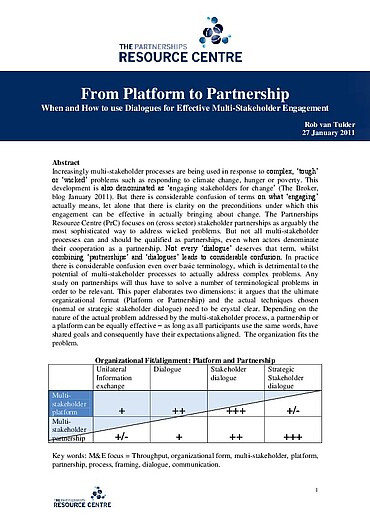Abstract
Increasingly multi-stakeholder processes are being used in response to complex, „tough‟ or „wicked‟ problems such as responding to climate change, hunger or poverty. This development is also denominated as „engaging stakeholders for change‟ (The Broker, blog January 2011). But there is considerable confusion of terms on what „engaging‟ actually means, let alone that there is clarity on the preconditions under which this engagement can be effective in actually bringing about change. The Partnerships Resource Centre (PrC) focuses on (cross sector) stakeholder partnerships as arguably the most sophisticated way to address wicked problems. But not all multi-stakeholder processes can and should be qualified as partnerships, even when actors denominate their cooperation as a partnership. Not every „dialogue‟ deserves that term, whilst combining partnerships‟ and „dialogues‟ leads to considerable confusion. In practice there is considerable confusion even over basic terminology, which is detrimental to the potential of multi-stakeholder processes to actually address complex problems. Any study on partnerships will thus have to solve a number of terminological problems in order to be relevant. This paper elaborates two dimensions: it argues that the ultimate organizational format (Platform or Partnership) and the actual techniques chosen (normal or strategic stakeholder dialogue) need to be crystal clear. Depending on the nature of the actual problem addressed by the multi-stakeholder process, a partnership or a platform can be equally effective – as long as all participants use the same words, have shared goals and consequently have their expectations aligned. The organization fits the problem.
